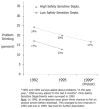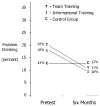Team awareness, problem drinking, and drinking climate: workplace social health promotion in a policy context
- PMID: 15559710
- PMCID: PMC3177956
- DOI: 10.4278/0890-1171-19.2.103
Team awareness, problem drinking, and drinking climate: workplace social health promotion in a policy context
Abstract
Purpose: (1) To determine the effectiveness of classroom health promotion/prevention training designed to improve work climate and alcohol outcomes; (2) to assess whether such training contributes to improvements in problem drinking beyond standard workplace alcohol policies.
Design: A cross-sectional survey assessed employee problem drinking across three time periods. This was followed by a prevention intervention study; work groups were randomly assigned to an 8-hour training course in workplace social health promotion (Team Awareness), a 4-hour informational training course, or a control group. Surveys were administered 2 to 4 weeks before and after training and 6 months after posttest.
Setting and subjects: Employees were surveyed from work departments in a large municipality of 3000 workers at three points in time (year, sample, and response rates are shown): (1) 1992, n = 1081, 95%; (2) 1995, n = 856, 97%; and (3) 1999, n = 587, 73%. Employees in the 1999 survey were recruited from safety-sensitive departments and were randomly assigned to receive the psychosocial (n = 201), informational (n = 192), or control (n = 194) condition.
Intervention: The psychosocial program (Team Awareness) provided skills training in peer referral, team building, and stress management. Informational training used a didactic review of policy, employee assistance, and drug testing.
Measures: Self-reports measured alcohol use (frequency, drunkenness, hangovers, and problems) and work drinking climate (enabling, responsiveness, drinking norms, stigma, and drink with co-workers).
Results: Employees receiving Team Awareness reduced problem drinking from 20% to 11% and working with or missing work because of a hangover from 16% to 6%. Information-trained workers also reduced problem drinking from 18% to 10%. These rates of change contrast with changes in problem drinking seen from 1992 (24%) to 1999 (17%). Team Awareness improvements differed significantly from control subjects, which showed no change at 13%. Employees receiving Team Awareness also showed significant improvements in drinking climate. For example, scores on the measure of coworker enabling decreased from pretest (mean = 2.19) to posttest (mean = 2.05) and follow up (mean = 1.94). Posttest measures of drinking climate also predicted alcohol outcomes at 6 months.
Conclusion: Employers should consider the use of prevention programming as an enhancement to standard drug-free workplace efforts. Team Awareness training targets work group social health, aligns with employee assistance efforts, and contributes to reductions in problem drinking.
Figures
References
-
- Bahls JE. Drugs in the workplace. HR magazine. 1998;43:80–87.
-
- Bacharach SB, Bamberger PA, Sonnenstuhl WJ. Driven to drink: managerial control, work-related risk factors, and employee problem drinking. Acad Manage J. 2002;45:637–658.
-
- Hoffman J, Larison C. Worker drug use and workplace drug-testing programs: results from the 1994 national household survey on drug abuse. Contemp Drug Prob. 1999;26:331–354.
-
- Hartwell TD, Steele PD, Rodman NF. Work-place alcohol-testing programs: prevalence and trends. Mon Labor Rev. 1998;121:27–34.
-
- Truxillo D, Bauer T, Paronto ME. Reactions to organizational alcohol testing and treatment programs. J Bus Psychol. 2002;17:31–45.
Publication types
MeSH terms
Grants and funding
LinkOut - more resources
Full Text Sources
Medical




